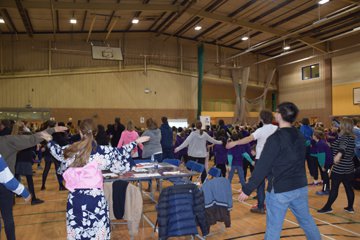Bringing Japanese into Primary Schools
The Japan Foundation, London
NETSU Makoto
I was dispatched to The Japan Foundation, London (hereinafter “JF London”), one of the overseas offices of the Japan Foundation, to support Japanese-language education for children through adults in the UK. Here I will report on the challenges facing the introduction of Japanese-language education for primary schools and the latest initiatives to solve those issues.
The Challenging State of Foreign Language Education in Primary Schools
As was reported in 2014 (in Japanese), foreign language education became compulsory in public primary schools in England starting in 2014. While some on the front line of primary schools say that foreign language education can play a major role in teaching social inclusion, there are also many challenges facing the introduction of such languages, not just Japanese. The current national curriculum emphasizes the core subjects of English, Mathematics, and Science, and a national scholastic test is held for pupils to measure academic performance starting in primary schools. Meanwhile, the teaching approach and time spent on other “basic subjects” and “other subjects” is left up to individual schools to some extent. An examination of the actual schools, however, shows that it can be challenging to even secure 30 minutes per week for foreign language studies, or cases where there is no adequate budget allocated. Furthermore, the national curriculum does not stipulate which foreign languages are to be taught at primary schools, so the majority teach either French, Spanish, or German, which are the most studied languages at secondary schools. Therefore, other languages such as Japanese are generally taught during lunch break or as an after school activity. For these three European languages, the volume of fluent teachers and teaching materials, and the scope of the teacher training infrastructure, is incomparably richer than for any other languages. And even if it were to become possible to study Japanese in primary school, very few students would be able to go on to study the same language at their local secondary educational institutions after graduation.
Efforts for Integration into the Curriculum
Under these circumstances, one way to incorporate the Japanese language and other information about Japan into schools is to tie it to other subjects. An examination of the time allocation for a given week in a primary school shows that in addition to the time spent on the core subjects including literacy, reading (both English), and numeracy (mathematics), a great deal of time is allocated for themed studies. Ideas on using these themed studies and linking to other subjects were shared at the primary education training course held at JF London in January. Among those ideas was an actual case study of a primary school that linked mathematics and Japanese activities throughout the school. Fun activities that involve physical movement capture the children’s attention, but if linking them to Japanese can deepen the learning or make the subjects easier, then teachers will proactively adopt the approach. For example, Japanese words for digits, which follow simpler rules than English, and the abacus can be used when teaching the concept of numbers. The training was attended by both part-time teachers specializing in teaching Japanese, and by teachers and school masters from schools that have not adopted Japanese, enabling the two groups to acquire new information.
In 2017, we collaborated on a project by the Royal Zoological Society of Scotland to produce teaching materials that connect wildlife ecology and foreign language learning. Specifically, this involved a fun approach to learning through games to increase familiarity with Japanese and the geography of Japan using Japanese macaques as the topic.
Cooperation With Sports
In March 2018, I co-hosted an event in Coventry, a city in central England, with local primary schools and other organizations called the “Coventry Young Ambassador Japan Conference,” with an eye toward the Tokyo Olympics and Paralympics. A total of 250 children from 29 local primary schools gathered to experience sports, the Japanese language, and a variety of cultural activities, and then discussed on how to learn about Japan and generate more interest after they go back to school. This was a great example of developing a new Japan related network by leveraging local interest and the local volunteer network that was formed for the London Olympics, and similar events are being planned for other communities. Also in Coventry, the Young Ambassadors plans to continue their activities as leaders.

Coventry pupils and students practicing Japanese Radio Exercises.
Sports can be used not only to move the body, but also to connect with a variety of other types of learning. One school master I met at an exchange conference on Japanese-language education for secondary educational institution masters told me about their activity to learn about the “values” of the Olympics and Paralympics through exchange with Japanese students, with plans to involve local primary school pupils in the future. In this way, one enjoyable part of my job as a Japanese-Language Specialist is to work with local teachers to seek out ways to achieve greater spread of Japanese-language education unobtainable at the schools providing Japanese classes, and to discover new ways to put Japanese-language education into practice.
- What We Do Top
- Arts and Cultural Exchange [Culture]
- Japanese-Language Education Overseas [Language]
- Japanese-Language Education Overseas [Language] Top
- Learn Japanese-language
- Teach Japanese-language
- Take Japanese-Language Test
- Know about Japanese-language education abroad
- The Japanese-Language Institute, Urawa
- The Japanese-Language Institute, Kansai
- Japanese-Language Programs for Foreign Specified Skilled Worker Candidates
- Japanese Language Education for Japanese Children Resident Overseas and for the Descendants of Migrants
- Archives
- Japanese Studies and Global Partnerships [Dialogue]
- JF digital collection
- Other Programs / Programs to Commemorate Exchange Year
- Awards and Prizes
- Publications
